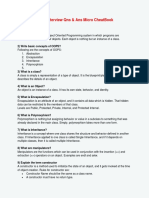0 ratings0% found this document useful (0 votes)
270 viewsLearn Java - Arrays and ArrayLists Cheatsheet - Codecademy
Arrays are fixed in size and store elements of the same data type. An array's index starts from 0. To create an array, use {} notation or the new keyword. The value at a specific index can be accessed or changed.
ArrayLists are dynamic lists that allow adding and removing elements. An ArrayList is created using new ArrayList<>() and elements are added/removed using add() and remove() methods. The remove() method can specify an index or element to remove.
Uploaded by
ilias ahmedCopyright
© © All Rights Reserved
Available Formats
Download as PDF, TXT or read online on Scribd
0 ratings0% found this document useful (0 votes)
270 viewsLearn Java - Arrays and ArrayLists Cheatsheet - Codecademy
Arrays are fixed in size and store elements of the same data type. An array's index starts from 0. To create an array, use {} notation or the new keyword. The value at a specific index can be accessed or changed.
ArrayLists are dynamic lists that allow adding and removing elements. An ArrayList is created using new ArrayList<>() and elements are added/removed using add() and remove() methods. The remove() method can specify an index or element to remove.
Uploaded by
ilias ahmedCopyright
© © All Rights Reserved
Available Formats
Download as PDF, TXT or read online on Scribd
You are on page 1/ 2
Cheatsheets / Learn Java
Arrays and ArrayLists
Arrays
In Java, an array is used to store a list of elements of the
same datatype. // Create an array of 5 int elements
Arrays are fixed in size and their elements are ordered. int[] marks = {10, 20, 30, 40, 50};
Array creation in Java
In Java, an array can be created in the following ways:
int[] age = {20, 21, 30};
● Using the {} notation, by adding each element all
at once.
int[] marks = new int[3];
● Using the new keyword, and assigning each marks[0] = 50;
position of the array individually. marks[1] = 70;
marks[2] = 93;
Index
An index refers to an element’s position within an array.
The index of an array starts from 0 and goes up to one int[] marks = {50, 55, 60, 70, 80};
less than the total length of the array.
System.out.println(marks[0]);
// Output: 50
System.out.println(marks[4]);
// Output: 80
Changing an Element Value
To change an element value, select the element via its
index and use the assignment operator to set a new value. int[] nums = {1, 2, 0, 4};
// Change value at index 2
nums[2] = 3;
Java ArrayList
In Java, an ArrayList is used to represent a dynamic list.
While Java arrays are fixed in size (the size cannot be // import the ArrayList package
modified), an ArrayList allows flexibility by being able to import java.util.ArrayList;
both add and remove elements.
// create an ArrayList called students
ArrayList<String> students = new
ArrayList<String>();
Modifying ArrayLists in Java
An ArrayList can easily be modified using built in
methods. import java.util.ArrayList;
To add elements to an ArrayList , you use the add()
method. The element that you want to add goes inside of public class Students {
the () . public static void main(String[] args) {
To remove elements from an ArrayList , you use the
remove() method. Inside the () you can specify the
// create an ArrayList called
index of the element that you want to remove.
Alternatively, you can specify directly the element that
studentList, which initially holds []
you want to remove. ArrayList<String> studentList
= new ArrayList<String>();
// add students to the ArrayList
studentList.add("John");
studentList.add("Lily");
studentList.add("Samantha");
studentList.add("Tony");
// remove John from the ArrayList,
then Lily
studentList.remove(0);
studentList.remove("Lily");
// studentList now holds [Samantha,
Tony]
System.out.println(studentList);
}
}
You might also like
- Dr. Basant Agarwal - Hands-On Data Structures and Algorithms With Python - Store, Manipulate, and Access Data Effectively, 3rd Edition-Packt (2022)0% (1)Dr. Basant Agarwal - Hands-On Data Structures and Algorithms With Python - Store, Manipulate, and Access Data Effectively, 3rd Edition-Packt (2022)10 pages
- Learn Java - Arrays and ArrayLists Cheatsheet - CodecademyNo ratings yetLearn Java - Arrays and ArrayLists Cheatsheet - Codecademy3 pages
- Learn Java_ Arrays and ArrayLists Cheatsheet _ CodecademyNo ratings yetLearn Java_ Arrays and ArrayLists Cheatsheet _ Codecademy3 pages
- Learn Java - Arrays and ArrayLists Cheatsheet - Codecademy PDFNo ratings yetLearn Java - Arrays and ArrayLists Cheatsheet - Codecademy PDF4 pages
- Java Collections: // Declare The List Concrete Type Is ArraylistNo ratings yetJava Collections: // Declare The List Concrete Type Is Arraylist4 pages
- Collections Framework - List, Set, Map.No ratings yetCollections Framework - List, Set, Map.25 pages
- Java Programming Tutorial With Screen Shots & Many Code ExampleFrom EverandJava Programming Tutorial With Screen Shots & Many Code ExampleNo ratings yet
- Learn Java - Object-Oriented Java Cheatsheet - CodecademyNo ratings yetLearn Java - Object-Oriented Java Cheatsheet - Codecademy7 pages
- Web Development Fundamentals - Learn HTML - Elements Cheatsheet - CodecademyNo ratings yetWeb Development Fundamentals - Learn HTML - Elements Cheatsheet - Codecademy5 pages
- JavaScript Syntax, Part I - Learn JavaScript Syntax - Introduction Cheatsheet - Codecademy100% (1)JavaScript Syntax, Part I - Learn JavaScript Syntax - Introduction Cheatsheet - Codecademy6 pages
- Learn JQuery - Learn JQuery - Event Handlers Cheatsheet - CodecademyNo ratings yetLearn JQuery - Learn JQuery - Event Handlers Cheatsheet - Codecademy2 pages
- Learn Java - Access, Encapsulation, and Static Methods Cheatsheet - CodecademyNo ratings yetLearn Java - Access, Encapsulation, and Static Methods Cheatsheet - Codecademy6 pages
- Introduction To Cybersecurity - Case Studies & Looking Ahead Cheatsheet - CodecademyNo ratings yetIntroduction To Cybersecurity - Case Studies & Looking Ahead Cheatsheet - Codecademy2 pages
- Beginner HTML - Elements and Structure Cheatsheet - CodecademyNo ratings yetBeginner HTML - Elements and Structure Cheatsheet - Codecademy7 pages
- Git and Github, Part I - Introduction To Git Cheatsheet - CodecademyNo ratings yetGit and Github, Part I - Introduction To Git Cheatsheet - Codecademy3 pages
- Learn JQuery - Learn JQuery - Traversing The DOM Cheatsheet - CodecademyNo ratings yetLearn JQuery - Learn JQuery - Traversing The DOM Cheatsheet - Codecademy2 pages
- Learn JQuery - Learn JQuery - Introduction Cheatsheet - CodecademyNo ratings yetLearn JQuery - Learn JQuery - Introduction Cheatsheet - Codecademy2 pages
- Profile - Ilias Ahmed - CodecademyreactreduxappsNo ratings yetProfile - Ilias Ahmed - Codecademyreactreduxapps1 page
- Programming Logic With Java - Conditionals and Control Flow Cheatsheet - CodecademyNo ratings yetProgramming Logic With Java - Conditionals and Control Flow Cheatsheet - Codecademy4 pages
- Profile - Ilias Ahmed - CodecademycybersecurityNo ratings yetProfile - Ilias Ahmed - Codecademycybersecurity1 page
- Sign in To Your Payoneer Account - Payoneer LoginNo ratings yetSign in To Your Payoneer Account - Payoneer Login1 page
- Profile - Ilias Ahmed - Codecademyfullstack EnggNo ratings yetProfile - Ilias Ahmed - Codecademyfullstack Engg1 page
- Learn SQL - Aggregate Functions Cheatsheet - CodecademyNo ratings yetLearn SQL - Aggregate Functions Cheatsheet - Codecademy2 pages
- Learn SQL - Multiple Tables Cheatsheet - CodecademyNo ratings yetLearn SQL - Multiple Tables Cheatsheet - Codecademy2 pages
- Learn SQL - Manipulation Cheatsheet - CodecademyNo ratings yetLearn SQL - Manipulation Cheatsheet - Codecademy2 pages
- A Resource Allocation Strategy Using PSONo ratings yetA Resource Allocation Strategy Using PSO4 pages
- Tugas Algoritma & Pemrograman (C#) : A. Pembelian 1. Desain FormNo ratings yetTugas Algoritma & Pemrograman (C#) : A. Pembelian 1. Desain Form6 pages
- Java - Introduction To Programming: Patterns - Part 2No ratings yetJava - Introduction To Programming: Patterns - Part 28 pages
- BSE2107 OOP II - Inner Classes in Java-1No ratings yetBSE2107 OOP II - Inner Classes in Java-125 pages
- Oops Interview Qns & Ans Micro CheatbookNo ratings yetOops Interview Qns & Ans Micro Cheatbook10 pages
- 19-12-2023 SR - Super60 Phase-1 Assignment MATHSNo ratings yet19-12-2023 SR - Super60 Phase-1 Assignment MATHS8 pages
- Artificial Intelligence and Machine Learning - July 2021No ratings yetArtificial Intelligence and Machine Learning - July 202149 pages
- Fruit Freshness Detection Using Android-Based Transfer Learning MobileNetV2No ratings yetFruit Freshness Detection Using Android-Based Transfer Learning MobileNetV210 pages
- Toc Lab Experiment List: (Java Formal Languages and Automata Package)100% (1)Toc Lab Experiment List: (Java Formal Languages and Automata Package)43 pages
- Fundamentals of Algorithms CS - 201: Lab Manual 2No ratings yetFundamentals of Algorithms CS - 201: Lab Manual 28 pages





















































































































